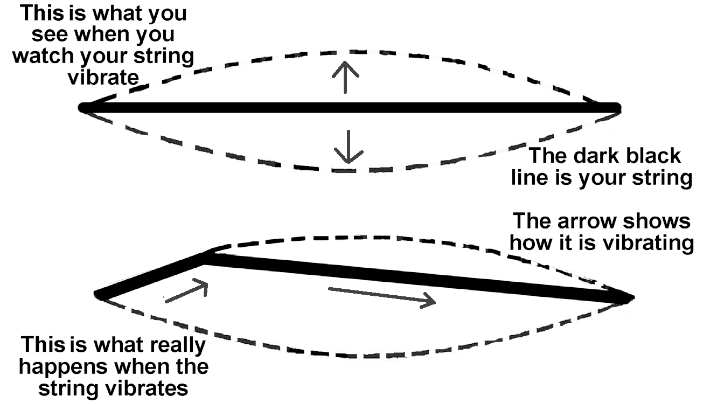The following exercise can be useful to help re-calibrate the students’ ear to what to listen for in making a “good” tone on their string instrument.
Practice Exercise: Learning to Play with Helmholtz Motion
1) Have students play their open D-string, and ask them to watch their string vibrate.
2) Ask them to make their open D-string vibrate as wide as possible.
3) Ask them to describe what the vibrating string looks like. Answers may be: (1) wiggling, (2) moving back and forth, or (3) moving to one side.
4) Draw the figure below to illustrate the actual motion of the string compared to what the naked eye sees
5) Have students play their open D-string again, reminding them to make the string vibrate widely in Helmholtz motion. Some of my students say they can see the string vibrate differently now. This is when I do a lot of smiling and raising my eyebrows.
As string teachers, we know that “good” tone depends on more than friction between the bow hair and the strings; it also includes bow speed and bow placement. So while the students are playing their open D-string in Helmholtz motion, I guide them into doing a few more “things,” which can be turned into a take-home checklist to help students develop necessary habits for producing “good” tone. Encourage students to follow each item on the checklist during independent practice.
- I suggest they put more pressure on the string using their bow-thumb and bow-first finger like a lever.
- I suggest that they slow their bow-speed so that they feel their horsehairs “catch” the string.
- I ask if their bow is traveling straight between the fingerboard and the bridge.
- I ask them to bow closer to the bridge, especially if students play on mass-produced instruments with a poorly set bridge. Students may play softly to keep from playing more than one string at a time. Having them bow closer to the bridge allows them to “play into the wood of the bow,” and play on one string at a time. [1]
6) Ask students what their instrument sounds like when they play with Helmholtz Motion. Answers may be: (1) screechy (2) throaty (3) raspy or, (4) loud! Remind them that Professor Helmholtz referred to this sound as “metallic” and this is the sound they need to listen for when they play.
I look forward to hearing feedback from you after you teach this exercise to one of your students. I have found that in just asking a student to watch their string vibrate, changes their focus from the left hand to the right. Please let me know if you find this to be true also.
[1] Fischer, Simon, “Playing into the Wood of the Bow,” The Strad 118, no. 1401 (January 2007), 66.















Thanks for very useful info! This article makes it very easy to understand about how to make a good tone.
This is a fascinating article. Having played violin/fiddle for about 40 years, a few years ago I decided to try making violins – first from a Stewart-MacDonald kit, and then from scratch, a total of eight so far. I also have three violins made in Germany.
Of these, my favorite was bought (from Sears-Roebuck or Montgomery Ward, I believe), by a girl in the mid-western US, probably in the 1920s. One of my friends helped her pack up and move to a retirement home, and she gave it to him. It apparently had spent about half a century in the attic of the house that she was leaving, and it looked terrible. Figuring that I couldn’t hurt it much, I removed everything but the neck, stripped off the old, crackled varnish,… and found an unsophisticated but very presentable violin. Once I had refinished and refitted it, it quickly became my favorite of all the violins I have ever played. It is enjoyable and comfortable to play for hours at a time, its volume range is impressive, and its tonal range lacks the sharp nasal qualities that bother me in my other violins.
I am currently trying to analyze my luthiery techniques and make whatever changes are needed so that all of my violins are as captivating as that one bought from a catalog nearly a century ago. I don’t doubt that there are benefits of incorporating Helmholtz Motion concepts into one’s playing, but the idea that I play that violin differently from the way I play all others just doesn’t add up. My question is: What is the physical difference that makes this “cheap” violin’s tone so superior to that of all the other violins I have played – and in particular, those that I have made?
https://ww88.enterprises